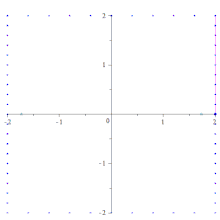Ellipse
From Wikipedia, the free encyclopedia
This article is about the geometric figure. For other uses, see Ellipse (disambiguation).
"Elliptical" redirects here. For the exercise machine, see Elliptical trainer.
Not to be confused with Ellipsis.

An ellipse obtained as the intersection of a cone with an inclined plane
Ellipses are the closed type of conic section: a plane curve resulting from the intersection of a cone by a plane (see figure to the right). Ellipses have many similarities with the other two forms of conic sections: parabolas and hyperbolas, both of which are open and unbounded. The cross section of a cylinder is an ellipse, unless the section is parallel to the axis of the cylinder.
Analytically, an ellipse may also be defined as the set of points such that the ratio of the distance of each point on the curve from a given point (called a focus or focal point) to the distance from that same point on the curve to a given line (called the directrix) is a constant. This ratio is called the eccentricity of the ellipse.
Ellipses are common in physics, astronomy and engineering. For example, the orbit of each planet in our solar system is approximately an ellipse with the barycenter of the planet–Sun pair at one of the focal points. The same is true for moons orbiting planets and all other systems having two astronomical bodies. The shapes of planets and stars are often well described by ellipsoids. Ellipses also arise as images of a circle under parallel projection and the bounded cases of perspective projection, which are simply intersections of the projective cone with the plane of projection. It is also the simplest Lissajous figure formed when the horizontal and vertical motions are sinusoids with the same frequency. A similar effect leads to elliptical polarization of light in optics.
The name, ἔλλειψις (élleipsis, "omission"), was given by Apollonius of Perga in his Conics, emphasizing the connection of the curve with "application of areas".
Contents
[hide]- 1 Elements of an ellipse
- 2 Drawing ellipses
- 3 Mathematical definitions and properties
- 3.1 In Euclidean geometry
- 3.2 In projective geometry
- 3.3 In analytic geometry
- 3.4 In trigonometry
- 3.5 As a parametric rational polynomial
- 3.6 Degrees of freedom
- 4 Applications
- 5 See also
- 6 Notes
- 7 References
- 8 External links
Elements of an ellipse[edit]
See also: Features of conic sections
The semi-major axis (denoted by a in the figure) and the semi-minor axis (denoted by b in the figure) are one half of the major and minor axes, respectively. These are sometimes called (especially in technical fields) the major and minor semi-axes,[2][3] the major and minor semiaxes,[4][5] or major radius and minor radius.[6][7][8][9]
The four points where these axes cross the ellipse are the vertices and are marked as a, −a, b, and −b. In addition to being at the largest and smallest distance from the center, these points are where the curvature of the ellipse is maximum and minimum.[10]
The two foci or focal points of an ellipse are two special points F1 and F2 on the ellipse's major axis that are equidistant from the center point. The sum of the distances from any point P on the ellipse to those two foci is constant and equal to the major axis (PF1 + PF2 = 2a) (in the figure to the right this corresponds to the sum of the two green lines equaling the length of the major axis that goes from −a to a).
The distance to the focal point from the center of the ellipse is sometimes called the linear eccentricity, f, of the ellipse. Here it is denoted by f, but it is often denoted by c. Due to the Pythagorean theorem and the definition of the ellipse explained in the previous paragraph: f 2 = a2 −b2.
The eccentricity of an ellipse, usually denoted by ε or e, is the ratio of the distance between the two foci, to the length of the major axis or e = 2f/2a = f/a. For an ellipse the eccentricity is between 0 and 1 (0 < e < 1). When the eccentricity is 0 the foci coincide with the center point and the figure is a circle. As the eccentricity tends toward 1, the ellipse gets a more elongated shape. It tends towards a line segment (see below) if the two foci remain a finite distance apart and a parabola if one focus is kept fixed as the other is allowed to move arbitrarily far away. The eccentricity is also equal to the ratio of the distance (such as the (blue) line PF2) from any particular point on an ellipse to one of the foci to the perpendicular distance to the directrix from the same point (line PD), e = PF2/PD.
Drawing ellipses[edit]

Trammel of Archimedes (ellipsograph) animation
Pins-and-string method[edit]
The characterization of an ellipse as the locus of points so that sum of the distances to the foci is constant leads to a method of drawing one using two drawing pins, a length of string, and a pencil.[11] In this method, pins are pushed into the paper at two points, which become the ellipse's foci. A string tied at each end to the two pins and the tip of a pencil pulls the loop taut to form a triangle. The tip of the pencil then traces an ellipse if it is moved while keeping the string taut. Using two pegs and a rope, gardeners use this procedure to outline an elliptical flower bed—thus it is called the gardener's ellipse.[12]The gardener's ellipse: worked example[edit]
Create an ellipse 3.0m by 1.5mTools required:
- 5 pegs and a mallet to drive them
- a ball of non-stretchy cotton string or bricklayers line
- a calculator
- Place center peg at C (the center of the ellipse)
- Determine the orientation of the long (major) axis and, if desired, place a long line (longer than the major axis) along that axis passing through C
- Write down the major radius (a) and minor radius (b), that is, half of the full major/minor axes:
- Calculate the positions of the foci (F1) and (F2)
Note: This is the distance CF. The distance F1F2 = 2598 - Place pegs accordingly at F1 and F2 on the orientation line you affixed at step 2.
- Cut the string to the length of the major axis, 2a (allowing for the knot and tail ends)
- Place the string on the ground around the pegs F1 and F2, pull taut and then moving around the periphery, mark as desired on the ground. It doesn't matter where you start/stop.
Trammel method[edit]
An ellipse can also be drawn using a ruler, a set square, and a pencil:- Draw two perpendicular lines M,N on the paper; these are the major (M) and minor (N) axes of the ellipse. Mark three points A, B, C on the ruler. A->C being the length of the semi-major axis and B->C the length of the semi-minor axis. With one hand, move the ruler on the paper, turning and sliding it so as to keep point A always on line N, and B on line M. With the other hand, keep the pencil's tip on the paper, following point C of the ruler. The tip traces out an ellipse.








No comments:
Post a Comment